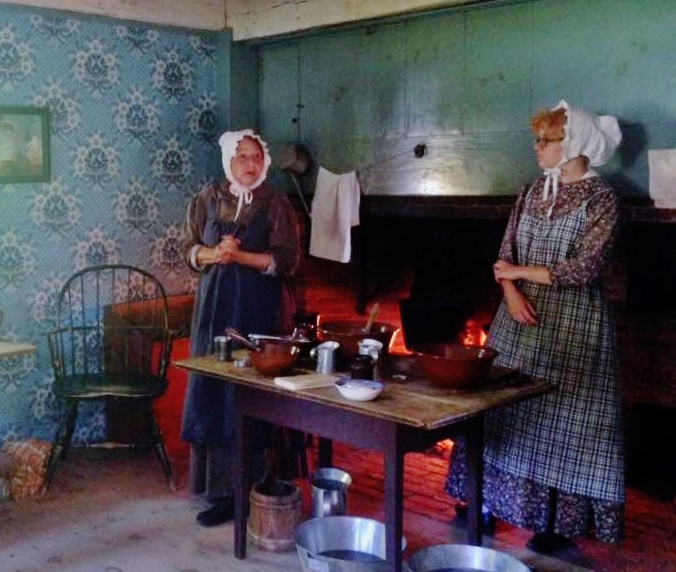Time Travel and Tinsmiths: Approaches to Interpretation at Outdoor History Sites
At Old Sturbridge Village, the fellows learned about which woods work best in constructing a yoke for oxen.
In our exploration of the cultural landscape and material culture of New England, the WPAMC fellows encountered a variety of approaches to interpretation and visitor engagement. Interpretation is an important vehicle for conveying the importance and relevance of material culture to visitors. In this post I explore how two outdoor sites brought the historic landscape and material culture to life through costumed interpretation.
Outdoor sites pose a set of unique challenges. Many living history sites balance historic nuance with visitors’ perceptions of the site’s authenticity. Outdoor sites often navigate complex layers in their community, like the private ownership of historic buildings or changes to the historic landscape. In combination with a variety of different visitor engagement methods, costumed interpretation at outdoor sites can create an atmosphere of play that helps visitors engage with and imagine their historic surroundings.
Ruth and Abby, the “1850s Ladies,” talk with the fellows about what life was like in New Bedford’s whaling days.
In New Bedford, Massachusetts, we experienced first-person interpretation at the New Bedford Whaling National Historic Park. After a walking tour of the community, the “1850s Ladies” served the group tea and talked with us about the history and the community from the perspective of nineteenth-century residents. It was evident that the interpreters had carefully studied the history of the community as well as the biographies of the women they were portraying. Their approach focused on the emotional element of history, as they connected with the group through personal narrative, painting a mental image of what it may have felt like to experience life in mid-nineteenth-century New Bedford. A more literal interpretation of bringing history to life, the New Bedford interpreters’ theatrical approach created an immersive, sensory experience in which audience members felt as if we could eavesdrop on period notions of social customs, class dynamics, politics, and domestic life. According to the NPS webpage for the site, the 1850s ladies host a variety of community events and public programming at the park, helping visitors connect and understand contemporary life by finding parallels with the past.
Though digital cameras were invented after their lifetime, the 1850s ladies were kind enough to pose for a picture with the group.
Old Sturbridge Village features authentically costumed historians interpreting New England life in the 1830s from a third-person perspective. In some of the village’s historic structures, we met interpreters preparing historic recipes at the hearth, and explaining what life might have been like for the residents in those homes. The tinsmith stopped his work to show the group differences between making eighteenth and nineteenth century seams in tin. Rather than focusing on historic biographies, Old Sturbridge Village’s approach favors immersion through one’s physical surroundings. Interpreters engage with the buildings, interiors, landscape, and objects to evoke a sense of historic authenticity for the visitor. The processes of craft and domesticity become tangible through the use of objects, and costumed historians explain their function and meaning while using them.
Costumed historians at Old Sturbridge Village explain what it might have been like to prepare a meal in a nineteenth-century interior.
Both sites use different methods of immersion to engage visitors with historic narratives. New Bedford is limited in their control over the physical landscape, as it is a contemporary residential community and a changing city. The 1850s Ladies’ approach offers visitors an effective way of immersing themselves in history through role-play and theater. They interpret history largely without objects, using period dress and personal narrative to deliver information about historic behaviors. Old Sturbridge Village has more control over its environment because the village represents an assemblage of historic buildings rather than a historic town. Therefore, the interpretation utilizes material culture to enliven history and create a sense of authenticity. Both sites emphasize the training and credibility of the interpreter as a vital means of visitor engagement. Both sites employ historians who know their roles and their history well. The examples of New Bedford and Old Sturbridge Village challenge us to consider which techniques best transmit information about daily life and material culture. Experiencing two approaches to living history interpretation in New England broadened my view of effective methods through which to interact with the material world of the past.
.
By Sarah Berndt, WPAMC Class of 2017





I am writing a nonfiction historical piece about my own family, and 2 generations Dennis (1820-89) and George (1847-1923) Donoghue were tinsmiths formally years and the next two generations Will (1874-1952) and Norman (1894-1973) worked in and owned hardware stores– all of them in Southeastern Pennsylvania. The photos I have of them are pretty interesting, one is really quite spectacular (I sent it to Winterthur some years ago). I would enjoy it if one of your students were interested in reading the piece and critiquing it with a view to getting it published in some journal relevant to 19th century tradesmen in this line in this mid-Atlantic area. Or some other form of perhaps co-production that can be published. Thanks.